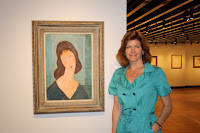Friday, September 23, 2011 -  Bernard Berenson,book reviews,Spring 2011,The Journal of Art Crime,Yearwood
Bernard Berenson,book reviews,Spring 2011,The Journal of Art Crime,Yearwood
 No comments
No comments
 Bernard Berenson,book reviews,Spring 2011,The Journal of Art Crime,Yearwood
Bernard Berenson,book reviews,Spring 2011,The Journal of Art Crime,Yearwood
 No comments
No comments
The Journal of Art Crime, Spring 2011: Douglas L. Yearwood Reviews books on Henry Walters, Bernard Berenson and Giuseppe Panza
Doug Yearwood, Director of the North Carolina Criminal Justice Analysis Center, has reviewed two books on collecting for the fifth issue of The Journal of Art Crime.
Henry Walters and Bernard Berenson: Collector and Connoisseur
by Stanley Mazaroff
John Hopkins University Press, 2010
Stanley Mazaroff, a retired barrister who returned to Johns Hopkins to pursue the study of art history, documents the tumultuous, dynamic and topsy-turvy love-hate relationship between the railroad tycoon and art collector, Henry Walters, and Bernard Berenson, a world renowned Italian Renaissance art expert and dealer, between 1902 and 1927. Drawing on extensive museum records and related archival documents, including the personal correspondence, papers and letters of the two men, the author cogently depicts the highs and lows of Walters collecting career, reveals the inherent difficulties of identifying works attributed, and misattributed, to the Italian masters all within the context of America's gilded age and the lust for anything remotely related to the Renaissance among the nation's most wealthy industrialists and their families.
Giuseppe Panza: Memories of a Collector
by Giuseppe Panza
Abbeville Press, 2008
Memories of a collector is Giuseppe Panza's autobiographical explication of his love, devotion and nearly obsessive desire to put together the best collection of modern or contemporary American art. Unlike Walters who often left purchases uncrated for months at a time, Panza was a true connoisseur, scholar and an extremely astute buyer who had an uncanny innate ability to know which artists and their works would become famous or desirable well before others in the market.
You may read the complete reviews in the Spring 2011 issue of The Journal of Art Crime by subscribing through the ARCA website or by purchasing individual copies through Amazon.com.














